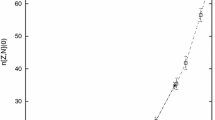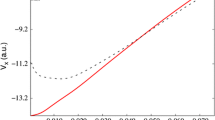Abstract.
We have analyzed and reduced a general (quantum-mechanical) expression for the atom-atom exchange energy formulated as a five-dimensional surface integral, which arises in studying the charge exchange processes in diatomic molecules. It is shown that this five-dimensional surface integral can be decoupled into a three-dimensional integral and a two-dimensional angular integral which can be solved analytically using a special decomposition. Exact solutions of the two-dimensional angular integrals are presented and generalized. Algebraic aspects, invariance properties and exact solutions of integrals involving Legendre and Chebyshev polynomials are also discussed.
Similar content being viewed by others
References
Abramowitz, M., Stegun, I.A.: Handbook of Mathematical Functions (9th printing). New York: Dover, 1972
Aubert-Frécon, M., Scott, T.C., Hadinger, G., Andrae, D., Grotendorst, J., Morgan III, J.D.: Asymptotically Exact Calculation of the Exchange Energies of One-Active-Electron Diatomic Ions with the Surface Integral Method. In preparation, 2004
Forrey, R.C.: Computing the Hypergeometric Function. J. Comput. Phys. 137, 79–100 (1997)
Geddes, K.O., Glasser, M.L., Moore, R.A., Scott, T.C.: Evaluation of Classes of Definite Integrals Involving Elementary Functions via Differentiation of Special Functions. AAECC 1, 149–165 (1990)
Gomez, C., Scott, T.: Maple Programs for Generating Efficient FORTRAN Code for Serial and Vectorised Machines. Comput. Phys. Commun. 115, 548–562 (1998)
Gradshteyn, I.S., Ryzhik, I.M.: Tables of Integrals, Series and Products (5th ed.). Boston: Academic Press, 1994
Grotendorst, J.: A Maple Package for Transforming Series, Sequences and Functions. Comput. Phys. Commun. 67, 325–342 (1991)
Hadinger, G., Hadinger, G., Bouty, O., Aubert-Frécon, M.: Asymptotic calculation of the exchange interaction between two long-range interacting atoms with open valence shells of any type. Phys. Rev. A 50, 1927–1930 (1994)
(a) Holstein, T.: Mobilities of positive ions in their parent gases. J. Phys. Chem. 56, 832–836 (1952); (b) Holstein, T.: Westinghouse Research Report 60-94698-3-R9 (1955, unpublished); (c) Herring, C.: Critique of the Heitler-London Method of Calculating Spin Couplings at Large Distances. Rev. Mod. Phys. 34, 631–645 (1962); (d) Bardsley, J.N., Holstein, T., Junker, B.R., Sinha, S.: Calculations of ion-atom interactions relating to resonant charge-transfer collisions. Phys. Rev. A 11, 1911–1920 (1975); (e) Herring, C., Flicker, M.: Asymptotic Exchange Coupling of Two Hydrogen Atoms. Phys. Rev. [Sect.] A 134, 362–366 (1964)
Kołos, W., Wolniewicz, L.: Variational calculation of the long-range interaction between two ground-state hydrogen atoms. Chem. Phys. Lett. 24, 457–460 (1974)
Levin, D.: Development of Nonlinear Transformations for Improving Convergence of Sequences. Int. J. Comput. Math. B 3, 371–388 (1973)
Preuß, H.: Zur Behandlung der Zweizentren-Wechselwirkungsintegrale. Z. Naturforsch. A 10, 211–215 (1955)
Prudnikov, A.P., Brychkov, Yu.A., Marichev, O.I.: Integrals and Series, Vol. 1 (4th printing). New York: Gordon & Breach, 1998
Sack, R.A.: Generalization of Laplace’s Expansion to Arbitrary Powers and Functions of the Distance between Two Points. J. Math. Phys. 5, 245–251 (1964)
Scott, T.C., Aubert-Frécon, M., Andrae, D.: Asymptotics of Quantum Mechanical Atom-Ion Systems. AAECC 13, 233–255 (2002)
Scott, T.C., Dalgarno, A., Morgan III, J.D.: Exchange Energy of H2+ Calculated from Polarization Perturbation Theory and the Holstein-Herring Method. Phys. Rev. Lett. 67, 1419–1422 (1991)
Scott, T.C., Babb, J.F., Dalgarno, A., Morgan III, J.D.: The Calculation of Exchange Forces: General Results and Specific Models. J. Chem. Phys. 99, 2841–2854 (1993)
Scott, T.C., Babb, J.F., Dalgarno, A., Morgan III, J.D.: Resolution of a Paradox in the Calculation of Exchange Forces for H2+. Chem. Phys. Lett. 203, 175–183 (1993)
Scott, T.C., Aubert-Frécon, M., Hadinger, G., Andrae, D., Morgan III, J.D.: Exchange Energy for Two-Active-Electron Diatomic Systems in the Surface Integral Method. In preparation, 2004
Smirnov, B.M., Chibisov, M.I.: Electron exchange and changes in the hyperfine state of colliding alkaline metal atoms. Sov. Phys. JETP 21, 624–628 (1965)
Spanier, J., Oldham, K. B.: An Atlas of Functions. Berlin: Springer, 1987
Umanskii, Ya.S., Hadinger, G., Aubert-Frécon, M.: Nonadiabatic formulation of the slow-atomic-collision problem in the finite electronic basis. Phys. Rev. A 49, 2651–2666 (1994)
Varshalovich, D.A., Moskalev, A.N., Khersonskii, V.K.: Quantum Theory of Angular Momentum. Singapore: World Scientific, 1988
Weniger, E.J.: Nonlinear Sequence Transformations for the Acceleration of Convergence and the Summation of Divergent Series. Comput. Phys. Rep. 10, 189–371 (1989)
Acknowledgments.
One of us (T.C.S.) would like to thank the members of Zentralinstitut für Angewandte Mathematik (ZAM - Central Institute for Applied Mathematics) and Arne Lüchow of the Institut für Physikalische Chemie, RWTH Aachen, and Georg Jansen of the Institut für Organische Chemie of the University of Essen for their wonderful hospitality and support for allowing this work to be possible. The author M.L.G. would like to thank the NSF for support under grant DMR0121146. We would also like to thank Juergen Hinze of the Theoretical Chemistry group at the University of Bielefeld (Faculty of Chemistry) and James Babb and Alexander Dalgarno of the Institute for Theoretical Atomic and Molecular Physics at the Harvard-Smithsonian Center for Astrophysics, for helpful discussions. Special thanks go to Bruno Salvy and Philippe Flajolet of INRIA-Rocquencourt (project ALGO) for their helpful hints with respect to asymptotic series expansions and Claude Gomez (project METALAU) for his assistance in the use of Macrofort. We would also like to thank Frédéric Desprez of the Ecole Normale Supérieure of Lyon and INRIA-Rhône-Alpes. Financial support for T.C.S. from the PSMN (ENS Lyon and Université Lyon 1) is gratefully acknowledged.
Author information
Authors and Affiliations
Corresponding author
Rights and permissions
About this article
Cite this article
Scott, T., Aubert-Frécon, M., Andrae, D. et al. Exchange Energy for Two-Active-Electron Diatomic Systems Within the Surface Integral Method. AAECC 15, 101–128 (2004). https://doi.org/10.1007/s00200-004-0156-6
Received:
Revised:
Published:
Issue Date:
DOI: https://doi.org/10.1007/s00200-004-0156-6




